The 722.9 New Automatic Gearbox 2 (NAG2) automatic transmission replaced the shifting linkage in some versions with an Intelligent Servo Module, or ISM.
Back in the day, selecting the auto trans gear was a mostly mechanical affair: a gear shift lever attached to a linkage, moving an arm on the side of the transmission. Just after the turn of the century, Mercedes-Benz came out with its 722.9 New Automatic Gearbox 2 (NAG2) automatic transmission, and replaced the shifting linkage in some versions with an Intelligent Servo Module, or ISM. In a future edition of StarTuned, we plan to talk about the care and feeding of the 722.9 transmission, but for today we’re going to focus on the ISM. These cars are most certainly showing up at your shop, so here’s what you need to know about this new technology.
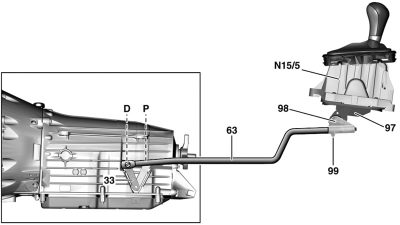
Even in models from just a few years ago, the shift lever and linkage arrangement served us well. Sure, you sometimes had to replace those plastic bushings on the linkage, and the shift-lock adjustment could get a bit fiddly, but for the most part things were good. As almost purely mechanical systems, they were also fairly easy to troubleshoot, repair, and replace.
But the stylists were just itching to get rid of that gear shift level taking up valuable real estate in the center console, and the engineers were looking for something that not only used fewer mechanical parts, but increased vehicle security as well. Thus the ISM was born, in support of the DIRECT SELECT system.
Little lever tip-off

You can spot a car equipped with DIRECT SELECT by the shift lever mounted to the side of the steering column. Unlike the column-shift levers of the past, this is an electrical switch: Tap once down for Drive, and once up for Reverse, and press the push-button on the end to put the trans into Park. (Some models have a conventional-looking shift lever — if there’s a button for Park, you know it uses DIRECT SELECT as well).
From a few feet away, the task of the ISM is remarkably simple: It moves a lever on the side of the transmission in response to the driver’s gear selection. Although it sounds like they just replaced the mechanical linkage rod with a small motor, there’s more to it that that. If we dissect the name Intelligent Servo Module, we can better understand what it’s doing. Module just means that it’s a control unit that is self-contained. Servo is the function of moving the transmission’s shift lever, and keeping track of the position. Intelligent means that this isn’t just a motor and sensor, but an integrated system for selecting a gear range.
The primary piece of intelligence is the theft protection system. As a component of the Drive Authorization System (DAS), the ISM needs to be unlocked by an encrypted message from the vehicle’s SmartKey. With DAS, the key (A8/1) first confirms with the Electronic Ignition Switch (N73) that it is the correct key for the vehicle. If it passes this test, the Electronic Ignition Switch sends out encrypted messages to each of the other DAS components: The ME-SFI engine control module (N3/10), the ISM (A80), and the Electronic Transmission Control module (Y3/8). All of these need to respond correctly with their own encrypted response before they’ll function.
Stuck in Park

While this makes it really difficult to steal a Mercedes-Benz if you don’t have a key, it can also bring a few headaches for the Independent Service Provider – you. The typical situation you might encounter is that the car comes in on the hook (hopefully a flatbed), with the transmission stuck in Park. In an emergency situation – say, an under-voltage in the electrical system, or communication with the ISM is faulty – a small motor in the ISM puts the transmission into Park, and you cannot shift out of park until the problem is fixed.
In normal operation, the main motor is controlled by the ISM’s internal electronics in response to data signals from the DIRECT SELECT lever. The motor drives a screw shaft through a toothed belt and pulley system (earlier versions used gears). A slide nut, driven by the screw shaft, physically moves the transmission shifter level to the desired position, and a sensor tells the system where the lever actually is. Easy enough, right?
If there’s a problem, the ISM needs to guarantee that it can put the trans into Park, so when a problem is detected, the Electronic Ignition Switch (EIS) can trigger the so-called Emergency-P Function. The EIS verifies that it is safe to put the transmission into Park (for example, the car is stopped), and then supplies power directly to the ISM on the Emergency-P pin, which drives the emergency motor in the ISM. The emergency motor slowly rotates an eccentric shaft, which pushes down on a button on the top of the sliding nut. When the eccentric pushes this button all the way down, the sliding nut de-couples from the screw shaft and the nut with the shifting lever are pushed by a spring into the Park position. There is no way to reverse the emergency motor from outside the ISM (and opening it is a disaster in the making), so the only way to make everything right again is to find and fix whatever sent the ISM into emergency-P mode in the first place.
Mini-batt
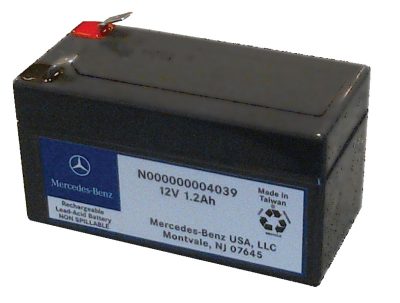
More recently produced cars can set the Emergency-P mode using the vehicle’s main battery, even if it is partly discharged. Earlier models had a separate emergency battery, about the size of two packs of cigarettes, mounted somewhere in the car. In models with ECO Start/Stop, the somewhat larger secondary battery used for that system also serves as the emergency battery.
So, if we have a car stuck in Park, we need to figure out if whatever triggered Emergency-P can be reversed. Almost every time, it’s been a dead (or nearly so) battery triggering the system, so simply restoring system voltage usually brings the ISM out of Emergency-P mode. There is also a way to use XENTRY to bring the car out of Park and into Neutral, which might be handy for moving the car into a service bay.
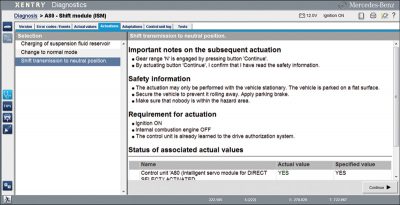
Every so often we see codes in the XENTRY Diagnostics system for faulty communication to or from the ISM (A80) and one or more of the other control units. These need to be followed through and checked. Wiring concerns are at the top of the check list, but we use both the wiring and function diagrams from WIS or Star Wiring to develop a list of “players†(possible causes) for our diagnosis.
CAN-C
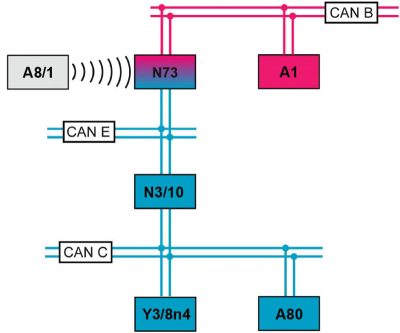
After supply voltage, our biggest player when it comes to ISM communications problems is the Engine CAN Bus (CAN-C), so we start by taking a voltmeter measurement between the two CAN Bus wires. We expect to see a DC voltage (measured to ground) of about 2.4 or 2.6V in a normally-functioning Bus. If we see 0V, that wire of the bus is shorted to ground, while about 12V means that it is shorted to power. If both wires read exactly the same, we can suspect the wires are shorted together, while both reading 0 is probably an unplugged connector somewhere. Once you know what problem you’re looking for, it becomes a matter of separating the CAN Bus at the voltage distributor (check the wiring diagram for each particular model) and measuring each wire separately.
It is rare, but if the CAN communications problem isn’t related to the physical layer – wiring, connectors, and such – then it may be that some other control unit has gone crazy and is taking down the communications. We’ve seen this, but always connected to a bunch of other symptoms, the transmission staying in Park being the least of them.
XENTRY also has some tests for control module power supply, but if you can’t communicate with the ISM, check for battery voltage at the ISM electrical connector, and even if there is, be sure to repeat the test under load by measuring the supply voltage with the ISM connected. To do this, use the Mercedes-Benz electrical connector and test kit. Whatever you do, don’t compromise the water-tightness of the wires or connector.
Theft-Relevant
In the worst case – and to be honest, we’ve never had this happen – the ISM needs to be replaced. That opens up a whole new can of worms, because the ISM is a Theft-Relevant Part, or TRP, and that means the dealer is not allowed to sell the part to you unless you are enrolled in the NASTF Vehicle Security Professional (VSP) Registry. If you’re not already enrolled, and your customer’s car definitely needs an ISM (or any other TRP, for that matter), best send them off to the dealer right away, since enrollment takes some time, more than a few days in any case.
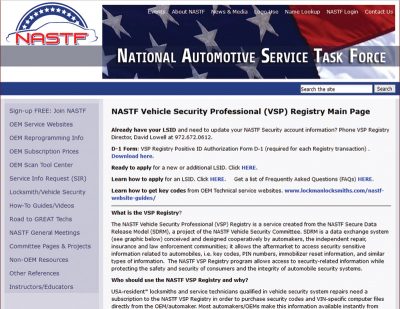
Way back in 2008, Mercedes-Benz updated its Theft-Relevant Parts policy to combat the rising trend of vehicle thefts using keys ordered from a dealer. For customers, the policy represents a bullet-proof assurance that nobody but they is going to get a key or other theft-relevant part for their car – after all, the value of a key is not what was paid, but the value of the car it can start. See the sidebar for a summary of the Mercedes-Benz TRP policy.
Just a short comment about the VSP Registry: If you are serious about servicing modern cars, you need to consider joining the VSP Registry. Originally intended to support locksmiths in getting vehicle key codes from manufacturers, the Registry has evolved into a general “circle of trust†between vehicle manufacturers and ISPs. Applicants to the Registry undergo a background check and agree to the terms and conditions, pay a fee for the initial two-year license, and, once accepted, can buy virtually all Theft-Relevant Parts from their dealer. Aside from Mercedes-Benz, many other manufacturers accept VSP Registry credentials for the purchase of restricted parts.
Specific VIN
Okay, let’s say you have been on the VSP Registry since forever, and you have concluded you need a new ISM to fix your customer’s car. Don’t bother buying a used ISM: They are programmed to a specific VIN, and that programming can’t be erased or changed. Instead, you need to complete the TRP form the dealer can provide (or download one from the STARTekInfo web site — no need to log in, just select the “Theft-Relevant Parts Info†link) and give them the proof they need: Proof of ownership, proof of identity (from the customer), and proof of your own identity (the form generated by the VSP registry). Once the part comes in, your dealer will want the old part so he or she can prove it has been destroyed, or at least your customer’s signature that the part has been kept by him or her.
Putting in the ISM isn’t as easy as bolting it on, though. You absolutely must have a XENTRY system and a valid XENTRY Flash account. The sale of the Theft-Relevant Part has been recorded by Daimler, and you need to log in to XENTRY Flash to activate and program the new part, as well as “marry†it to the specific vehicle. Unless you’re fully equipped for this task, you may better serve yourself and your customer by letting the dealer handle it.
Oh, and the bolts: They’re made of aluminum, and must be replaced each time they are loosened. Don’t try to re-use them as you’ll only end up breaking them and having to drill them out – after dropping the trans completely. Trust us, just buy the new bolts, and don’t ask how we know. Replace the vent hose as well, because it will leak if re-used. Small cost for a high-quality repair. Both these requirements, and a complete procedure, are found in WIS under Group 27.19.
Process
Since so many ISPs are indeed equipped to handle this task, let’s take a quick look at the process. If you are completely unable to communicate with the old ISM, you need to complete all of the tests in XENTRY to verify beyond all doubt that the ISM is indeed faulty and needs to be replaced. It’s worth spending some time on this simply because replacing the ISM can be challenging (particularly if you are not in the VSP Registry) and expensive. Once we conclude the ISM needs to be replaced, we install the new part and, using XENTRY, complete the routine for “Initial start-up of already installed control unit,†the first item on the Adaptations tab for A80. This is a multi-step procedure, but completely guided by XENTRY, so just follow the instructions on-screen. In this process, you’ll release the anti-theft transport protection of the new part, then personalize, activate, and enable the module for the specific VIN.
The next step is to calibrate the ISM, again using the procedure defined in XENTRY. This is how the ISM learns the correct positions for each shifter setting. Finally, you should use your XENTRY Flash account to verify that the control unit has the latest version of software installed. If it’s already up-to-date, the system will tell you, but if an update is needed, be sure you can guarantee the car’s battery voltage by using an approved battery maintainer, and the XENTRY system’s power supply by making sure the batteries of both the Tab and the Connect are fully-charged. Although rare, it is possible to “brick†(render completely inoperative) a new control unit if the update process is interrupted at the wrong spot.
We’re hoping it never gets that far, but perhaps with this bit of advice you’ll get through the process with a successful repair and a happy customer. As we mentioned, the ISM is rarely faulty, so be sure to follow up on all other possibilities before heading down this trail.
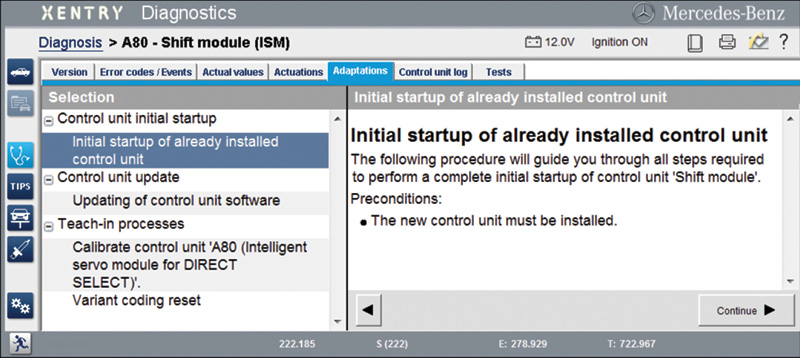








0 Comments